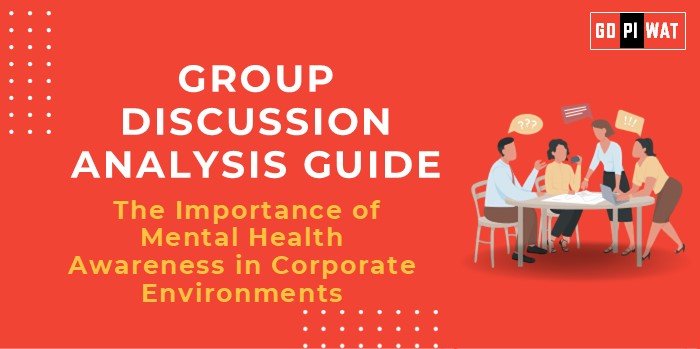📋 Group Discussion (GD) Analysis Guide: The Importance of Mental Health Awareness in Corporate Environments
🌐 Introduction to the Topic
- Opening Context: Mental health awareness has become a cornerstone of sustainable business practices, with studies showing that workplace stress costs the global economy over $1 trillion annually in lost productivity.
- Topic Background: Historically, mental health was a stigmatized subject, but increasing research and employee advocacy have brought it to the forefront. In corporate environments, mental health is now linked to organizational success, employee retention, and innovation.
📊 Quick Facts and Key Statistics
- 🌍 Global Cost of Mental Health Disorders: $1 trillion annually due to productivity losses (WHO).
- 📈 Employee Stress Rates: 44% of employees report experiencing workplace stress (Gallup, 2023).
- 💰 ROI on Mental Health Programs: $4 for every $1 spent on workplace mental health initiatives (Deloitte, 2022).
- 📉 Absenteeism Impact: Mental health-related absenteeism increased by 16% post-pandemic (Forbes).
👥 Stakeholders and Their Roles
- 🏢 Organizations: Design and implement mental health programs.
- 👩💼 Employees: Advocate for open conversations and utilize available resources.
- 🏛️ Governments: Create supportive policies like mandatory Employee Assistance Programs (EAPs).
- 🩺 Healthcare Providers: Offer counseling, therapy, and mental health screenings.
🏆 Achievements and Challenges
✨ Achievements
- Improved Productivity: Companies with robust mental health programs report a 12% increase in efficiency.
- Reduced Stigma: Initiatives like Bell’s Let’s Talk Campaign have normalized mental health conversations globally.
- Policy Advancements: Countries like Canada have introduced workplace mental health standards.
⚠️ Challenges
- Resource Allocation: Only 2% of global healthcare budgets are spent on mental health (WHO).
- Cultural Barriers: Mental health remains taboo in many regions, limiting awareness.
🌍 Global Comparisons
- Success Example: The UK’s Mental Health at Work Commitment has improved workplace outcomes.
- Challenge Example: Limited access to care in developing nations.
📋 Case Study
- Example: Google’s “Blue Dot Program” provides peer support for employees, improving engagement by 23%.
💡 Structured Arguments for Discussion
- Supporting Stance: “Mental health awareness programs have consistently reduced absenteeism and boosted employee morale.”
- Opposing Stance: “The high costs of implementation may deter SMEs from adopting comprehensive mental health initiatives.”
- Balanced Perspective: “While upfront costs exist, the long-term benefits of employee well-being far outweigh the investment.”
🔍 Effective Discussion Approaches
🌟 Opening Approaches
- Use data: “Stress-related productivity losses exceed $1 trillion annually—how can we afford to ignore this?”
- Highlight success: “Google’s employee well-being programs have set industry benchmarks.”
💬 Counter-Argument Handling
- Example: “Though costly, mental health programs yield a 400% ROI, making them financially viable.”
📈 Strategic Analysis of Strengths and Weaknesses
- Strengths: Increased awareness, measurable ROI, reduced stigma.
- Weaknesses: Cultural taboos, limited healthcare resources.
- Opportunities: AI-based mental health tools, government incentives.
- Threats: Mismanagement of data, insufficient trained professionals.
📘 Connecting with B-School Applications
- Real-World Applications:
- HR Strategies: Incorporate mental health programs in recruitment and retention plans.
- Leadership Training: Develop empathetic leaders capable of managing employee well-being.
- Sample Interview Questions:
- “How can mental health awareness improve organizational culture?”
- “Evaluate the role of leadership in promoting mental health initiatives.”
- Insights for B-School Students:
- Understand ROI calculations for well-being programs.
- Analyze global trends in workplace mental health policies.


